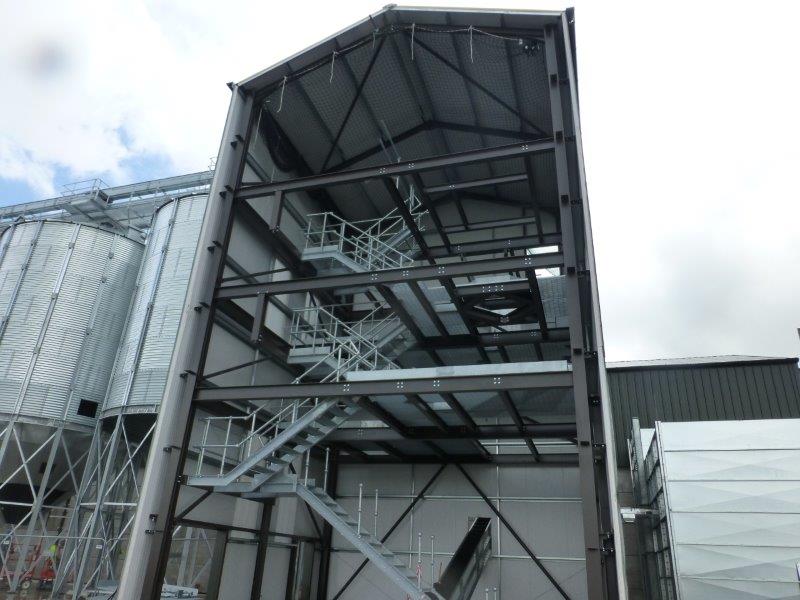
Why is Steel Used in Construction?
Steel is one of the most important materials in modern construction. It has transformed the way we build, making structures and bridges safer and longer-lasting. Steel is used in construction because of its strength, flexibility and how quick it is to work with. In this article we’ll explore why steel is used in construction by looking at its history, applications and key advantages.
Brief History of Steel in Construction
The use of steel in construction dates back to the 1800s. Initially, steel was expensive to produce and was primarily used for speciality items such as swords. However, in 1855, Sir Henry Bessemer in England developed the Bessemer Process. This revolutionary method made steel production more efficient and affordable, decreasing the cost of steel from £50 to £7.
Despite this innovation, both wrought and cast iron remained the dominant building materials throughout most of the 19th century. It wasn’t until the late 1800s that steel began to gain prominence, particularly in bridge construction.
One of the first major projects to showcase steel’s potential was the Brooklyn Bridge in New York, completed in 1883. It was the first bridge to make extensive use of steel for large-scale construction. This success inspired architects to explore steel for various building designs because of how quickly and easily it could be worked with.
Advancements in technology only sped up the construction process and in 1930 the Empire State Building was erected in only six months. The 85-story, 378-meter-high skyscraper featured 50,000 tons of steel, demonstrating how steel could revolutionise modern architecture.
Today, steel is one of the most widely used building materials, valued for its strength and versatility in construction projects worldwide.
What is Steel Used For in Construction?
Steel can be used in various parts of a building, from the foundation to the roof:
- Structural Framing: Steel beams, such as I-beams and H-beams, form the skeleton of buildings, especially skyscrapers and industrial structures.
- Reinforcing bars: Steel rods are embedded in concrete to add strength and prevent cracking.
- Roofing and Cladding: Steel sheets, often corrugated, are used for durable roofs and exterior walls.
- Support Structures: Steel columns and braces provide stability for large buildings.
Steel is used in many types of buildings, including bridges, high-rises, warehouses and industrial buildings. Offering many advantages, its durability, sustainability and flexibility are some of the main reasons for its use.
What are the Advantages of Steel in Construction?
Strength and Durability of Steel
One of the key advantages of steel is that it’s strong but lightweight, meaning less material is needed for supports and beams. Steel can handle strong impacts and forces, keeping people safe and doesn’t often need replacing over time. The high-strength ratio of steel allows it to bear heavy loads, making it ideal for supporting large and complex structures.
Quick Construction of Steel
Another advantage of steel is its ability to speed up construction. Steel parts can be made off-site and then quickly put together, which reduces build time. Since many steel components are pre-made, they can be easily bolted or welded into place, allowing for faster progress in building.
Sustainability of Steel
One of the environmental advantages of steel is that it is 100% recyclable. If a steel building needs to be taken down, it can be melted and reused. Additionally, during construction, if there is any waste left, it can be recycled too. The recycling process doesn’t affect its quality and using recycled steel can be cheaper than using wood or concrete. This makes steel a more sustainable choice for construction.
Fire Resistance of Steel
Steel doesn’t burn or release harmful gases, making it a safe choice for building and construction. Some types of steel construction are already built to resist fire and may not need extra fireproofing.
Steel Frame Building Advantages
Steel-framed buildings are used for industrial, commercial and residential buildings, such as:
- Manufacturing buildings
- Houses and blocks of flats
- Agricultural buildings
- Storage buildings
- Commercial buildings
Flexible Design of Steel Frame Buildings
Steel frame buildings are highly flexible in their design, allowing for large open spaces without the need for many internal supports. This makes them ideal for industries such as warehousing, manufacturing and agriculture, where layouts may need to change over time.
Steel structures can be easily expanded, modified or rearranged to accommodate business growth, new equipment or changing storage needs. Unlike traditional buildings, steel frames support wide spans, making it easier to create customised layouts.
Cost-effectiveness of Steel Frame Buildings
Steel frame buildings save money in the long run because they require less maintenance and last longer. Steel’s durability means fewer repairs and replacements are needed compared to buildings made from other materials such as wood. This makes it a more cost-effective option over time.
Steel Frame Buildings at Kit Buildings Direct
At Kit Buildings Direct, we specialise in high-quality steel-framed buildings that are designed to be strong, flexible and built to last. All of our steel is manufactured to CE-marked standards in our Derby workshop.
Our experienced team works closely with you to customise your steel frame building to meet your requirements. Don’t hesitate to contact us if you have any questions.

